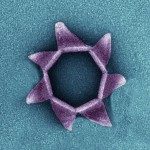Link to Pubmed [PMID] – 16014951
J. Virol. 2005 Aug;79(15):9904-11
Virus-like particles with five different morphotypes were observed in an enriched environmental sample from a hot, acidic spring (87 to 93 degrees C, pH 1.5) in Pozzuoli, Italy. The morphotypes included rigid rods, flexible filaments, and novel, exceptional forms. Particles of each type were isolated, and they were shown to represent viable virions of five novel viruses which infect members of the hyperthermophilic archaeal genus Acidianus. One of these, named the Acidianus bottle-shaped virus, ABV, exhibits a previously unreported morphotype. The bottle-shaped virion carries an envelope which encases a funnel-shaped core. The pointed end of the virion is likely to be involved in adsorption and channeling of viral DNA into host cells. The broad end exhibits 20 (+/- 2) thin filaments which appear to be inserted into a disk, or ring, and are interconnected at their bases. These filaments are apparently not involved in adsorption. ABV virions contain six proteins in the size range 15 to 80 kDa and a 23.9-kb linear, double-stranded DNA genome. Virus replication does not cause lysis of host cells. On the basis of its unique morphotype and structure, we propose to assign ABV to a new viral family, the Ampullaviridae.

